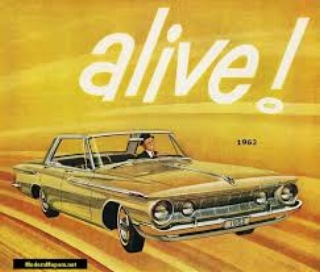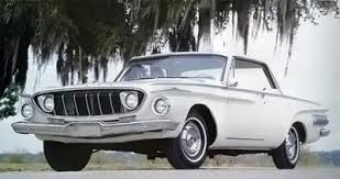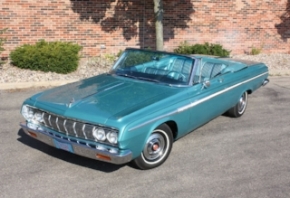Lets Get Small: The Unfortunate Tale of the 1962 Plymouth
/While “Let's get small” was likely the genius comedian Steve Martin’s greatest routine, getting small didn’t work out so well for the Chrysler Corporation and its new full sized cars of 1962. It was still funny, though in a different sort of way. Like watching a multi-billion dollar car company slip on a banana peel.
It all started on a pleasant spring Sunday in 1960. As the story goes, while attending a garden party, Chrysler President William C. Newberg overheard then Chevrolet boss, Ed Cole, talking to a companion about a downsized Chevy being developed for a 1962 introduction. This was alarming news for Newberg, who was in his first few weeks on the job. The industry had not yet recovered from a rather severe recession, and Chrysler’s big, swoopy and freshly redesigned 1960 cars were not showing signs of being well received in the marketplace. AMC’s irrepressible leader, George Romney, was all over the media claiming that the age of the “Detroit Dinosaur” was at an end. The AMC lineup of nearly exclusively smaller cars was nipping at Plymouth’s heels for the number three spot on the sales charts. This was leading commentators to suggest that the consumer’s tilt toward frugality was permanent. On top of all this, rumors were circulating of a smallerly small Ford out due in ’62. Fearing that the rest of the market was zigging small, as Chrysler zagged big, Newberg could perhaps be forgiven arriving at Chrysler headquarters Monday morning in a panic.
Willian C. Newberg
At that same time, Chrysler design chief Virgil M. Exner and his team were hard at work on an all-new full sized lineup for 1962. It would be a departure from his past themes. The prominent tail fins were gone, replaced with tucked wings swept strait back like a raptor in full dive. The proportions of the car were also swept back, emphasizing a long hood and short rear deck. Originating from prominent headlamps, another pair of tucked wings flowed gracefully into the front doors, lending further preeminence to the long wide hood. Between these subtle but elegant style lines was a sleek cabin section featuring side windows that were nearly flush with the doors, like the body of a jetliner. While this is common design practice today, in the early 60’s it was revolutionary. Exner had sought this ‘fuselage’ look for years but it was now made possible by a special curved side glass developed by supplier PPG. Ex referred to the new look as “Swept Wing,” and it might well have turned around Chrysler’s ailing fortunes, as well as his own.
1962 Plymouth Super Sport concept (www.Allpar.com)
Neither fortunes had been helped by Exner’s recent attempts at creating a modern interpretation of the 1930s Classic Era. The 1961 Plymouth was, to put it kindly, not well received.
1961 Plymouth Savoy: Bold but not so Beautifull (www.clunkbucket.com)
Then came that fateful Monday morning. Newberg was said to have marched into the studios and told Exner and his designers to drop what they were doing and get to work on a crash downsizing program. One stylist who was present that morning called it Chrysler’s “Day of Infamy.”
With about 20 months until the start of the ’62 model year, there was no time to design a new smaller car from scratch. The only viable option as to stretch the compact Valiant platform into a not so full sized full-sized car.
the compact 1962 Plymouth Valiant (www.fiftiesweb.com)
But Chrysler was short on funds. Still suffering lingering effects of the recession, the suits from finance were looking over everyone’s shoulder for cost savings. Then Virgil Exner was stricken with a heart attack, rendering him unable to muster his usual vigor to fight for his plans. With a directive from the president, little money to spend, and their leader laid low, the designers had no choice but to compromise - that dreaded solution that almost never produces anything pretty.
And it did not this time. In the interest of time, the Swept Wing styling theme was maintained. But so beautiful and flowing on the larger concept car, it looked awkward and top-heavy on a shorter, narrower Vailant-based body. To make matters worse, the accountants killed the expensive PPG curved glass that gave the car’s flanks their contour and helped integrate the body with the greenhouse.
Not so full-sized 1962 Plymouth Savoy (www.ClassicCarCatalogue.com)
Credit the stylists, however. While the results weren’t good, but they weren’t bad either. Given the unfortunate circumstances of the ’62 Plymouth, “not bad” is as good as one could hope for.
1962 Plymouth Fury Convertible: Not bad (www.fiftiesweb.com)
It was much worse for the Plymouth's sister car, the 1962 Dodge Dart, The impressionist Picasso might have considered the Dart a bit strange looking. One reviewer likened it to an “angry warthog.” With this one you have to wonder if the designers weren't delivering a middle fingered message to to their hapless senior management.
1962 Dodge Wart...I mean Dart
Despite his heart condition, Virgil Exner protested as vehemently as he could Newberg’s decision. Americans, he argued, would return to big cars just as soon as the nagging remnants of the recession were past. As it turned out, Ex was right.
And Newberg? He was as wrong as wrong can be. Nineteen sixty-two arrived, and the downsized Chevrolet that he had heard being discussed turned out to be a conventional new compact called the Chevy II. The big Impalas, Bel Airs and Biscanes were as full-sized as ever. The smaller Ford he’d heard rumored was the new Fairlane, slotted between the compact Falcon and the still very big Galaxy. Newberg, it turns out, made Chrysler zig while the rest of the industry had kept right on zagging.
It wasn’t all bad. Smaller means lighter…and lighter means faster.
William Newberg was not around for Exner to say ‘I told you so.” Just months after his decision to get small, Newberg became embroiled in a scandal involving kickbacks and nepotism, and was forced to resign. Ex wasn’t around either. Oh, he survived the heart attack. But between the market’s tepid response to his not at all tepid looking 1961 cars, and him publicly referring to the company's '62s as "plucked chickens," Ex got the axe, too.
Exner's replacement, Elwood Engle, who had been brought over from Ford after he had penned the instantly iconic 1961 Lincoln Continental, managed over the next two years to draw some pretty feathers onto those plucked chickens . Sales grew by 50% over that time.
1964 Plymouth Fury: A pretty little chicken (www.OldCarsWeekly.com)
For 1965, Engle unveiled his new from the ground up, fully full-sized 1965 cars. Sales rose another 19% and Plymouth was again the #3 selling car in America. The brand's decent into smallness had mercifully come to an end.
1965 Plymouth Fury: The biggest Plymouth yet (www.UniqueCarsandParts.AU)
Copyright@2018 by Mal Pearson
revised 2023











